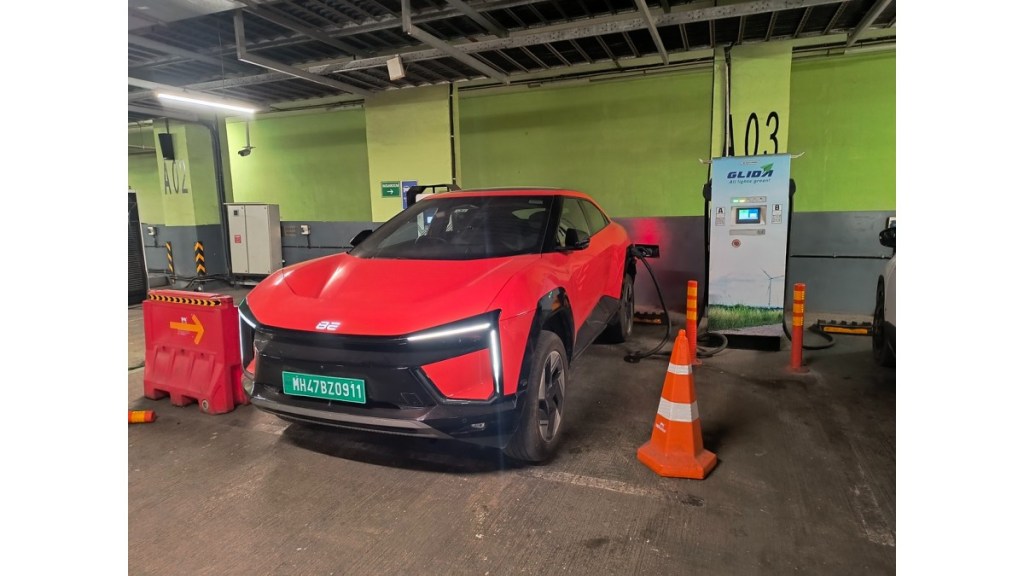This year has been a game-changer for electric cars.Previously, mass-market EVs – with a battery size of 30-55 kWh – had a real range of 250-400 km, making them inconvenient for long-distance journeys. While highways have had public chargers for a while, who wants to stop for an hour for a range boost?But with the launch of Mahindra’s XEV 9e and BE 6 – with 59-kWh and 79-kWh battery pack options – no destination seems too far for EVs.We took the BE 6 (79 kWh) from New Delhi to the edge of India – in one charge.
The car
The BE 6 looks like a concept car for display at auto shows – large 19-inch tyres, high floor, scooped bonnet for air intake, and in a world where carmakers are smoothening the edges, the BE 6 is as edgy as it can get.The cabin is equally radical – large screen, big pillar between the seats, a canvas band to open the doors, and a huge glass roof. The boot has 455-litre space, and there is a 45-litre frunk (front trunk).People we met on the way called it a spacecraft on wheels, a Lamborghini Urus-lookalike, and inspired by tesla Cybertruck.
The journey
At 92% charge, it showed a range of 475 km.The destination: The Sadqi-Sulemanki Indo-Pak border in Punjab, 420 km away.The road: The well-paved, four-lane NH-9 (Fazilka in Punjab to Askot in Uttarakhand).
The drive
Its claimed 0-100 km/h acceleration time is 6.7 seconds, and with no range anxiety, we could push it to its limits. The suspension is stiff – like that of sports cars – and that made driving on broken stretches uncomfortable. But on the largely smooth NH-9, it was fairly comfortable.
What we didn’t like?
– The sloping roofline limits the rear-seat headroom.– There is a lot of piano black finish – inside and outside – which attracts fingerprints and is prone to scratches.– Its high floor makes getting in and out difficult for older people.– It doesn’t have a dedicated physical button for AC (you have to use the touchscreen, which is slightly inconvenient).– The rear view from the cabin mirror is limited.
The destination
The closest ‘edge of India’ from New Delhi is the Sadqi-Sulemanki border near Fazilka (420 km away), where the Indian Border Security Force (BSF) jawans and Pakistani Rangers – while lowering their respective national flags in the evening – take part in a 45-minute parade that appears ferocious to some and patriotic to others. Wearing large turbans, shiny boots, and oiled moustaches, the jawans and rangers lift their legs high, kick in the air, and slam their heels on the ground, in a display of power and aggression.Similar parades are also held at the Hussainiwala-Ganda Singh Wala border near Firozpur (450 km from Delhi) and the Wagah-Attari border near Amritsar (500 km from Delhi).
Why such parades?
A BSF officer told us that these parades are a show of power and friendship. “It is as much a show of rivalry, as of brotherhood,” the officer said. “Both sides choose their best men, who are trained specifically for the parade. Both sides try to outdo each other. That’s competitive spirit.”
Why Sadqi-Sulemanki?
We chose this place because we could easily do this journey in a single charge – and it has a few advantages over Wagah.– It’s a lot less crowded, and you can even interact with BSF personnel.– You must visit the Asafwala War Memorial nearby, dedicated to Indian soldiers who fought in the 1971 Indo-Pak War.
Lesser-known fact
Once upon a time, Fazilka used to be a major wool and trading centre, so important that the British-India Steam Navigation Company named one of its largest ships as SS Fazilka – SS is an acronym for steamship. SS Fazilka was launched in 1890 and carried troops from India to South Africa during the Boer War. She was wrecked in 1919 near Great Nicobar, while on a voyage from Penang to Calcutta.
Going the distance
EVs with big batteries (50 kWh and above) can be used for long trips – thanks to improved range, growing charging infrastructure on highways (especially DC fast chargers), and faster charging speeds (a 30-minute DC fast charge can add more than 100 km range) – but there are some considerations:
– Planning: For trips longer than 250 km, it’s advisable to plan the route and charging stops in advance, especially if you are going to remote places (such as interiors of big states such as Madhya Pradesh and Rajasthan).
– Charging stations: You can download multiple EV charging apps (I used Tata Power and Statiq) to get access to a wider charging network.
– Charge at the first opportunity: Use the one-third rule – as soon as the battery drops to less than 50%, look for a charger, and never let it drop below 33% (one-third), unless your destination is round the corner.
– Weather: Extreme cold, such as in north India in winter, can reduce range, and you need to keep this in mind.
* The Banbasa-Mahendranagar border crossing between India and Nepal is closer to Delhi (at 360 km), but it’s a free border crossing.
